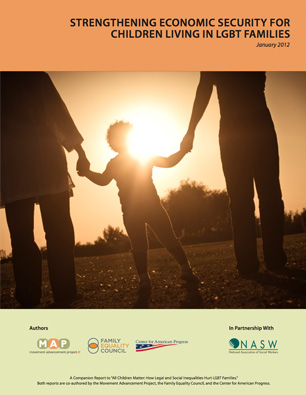The Bottom Line
Strengthening Economic Security for Children Living in LGBT Families, a comprehensive companion report to All Children Matter: How Legal and Social Inequalities Hurt LGBT Families, documents how inequitable laws hurt children of lesbian, gay, bisexual and transgender parents and contribute to higher rates of child poverty. It also provides a number of practical steps that governmental agencies, community-based organizations, advocates, and funders can take to assist and support all LGBT families.
Among the report’s recommendations: Expanding education and culturally competent training to those working with low-income LGBT families (including adoption agencies, child welfare departments, judges and law students, government agency workers, health service providers, schools, and faith communities); partnering with legal services or other organizations to create state-specific guidebooks for low-income LGBT families and their advocates to help them successfully understand, access and navigate safety net programs; creating and providing targeted training for school guidance counselors and social workers on safety net services for low-income LGBT families; and expanding outreach programs for low-income LGBT families, including LGBT families of color and LGBT families living in rural communities.
Developed in partnership with the National Association of Social Workers (NASW), this report was co-authored by the Movement Advancement Project (MAP), the Family Equality Council and the Center for American Progress.
Strengthening Economic Security for Children Living in LGBT FamiliesDownload
Recommended citation:
Movement Advancement Project, Family Equality Council, and Center for American Progress. January 2012.
Strengthening Economic Security for Children Living in LGBT Families.
https://www.lgbtmap.org/strengthening-economic-security-for-children-living-in-lgbt-families


